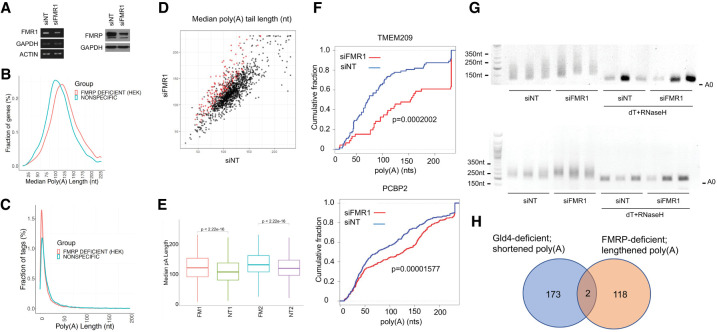FIGURE 2.
FMRP control of polyadenylation in HEK cells. (A) siRNA depletion of FMR1 RNA (left, RT-PCR) and FMRP protein (right, western blot analysis). siNT refers to a nontargeting siRNA. (B) Distribution of poly(A) tail lengths of RNAs versus fraction of genes in FMRP-deficient HEK cells as determined by TAIL-seq. (C) Distribution of poly(A) tail length versus fraction of sequence tags in FMRP-deficient HEK cells. (D) Scatter plot of median poly(A) length of RNAs from FMRP-depleted versus control (nontargeting siRNA). Log2 fold change of the ratio of siFMRP/siNT >1, >0.5, or <0.5 is indicated. (E) Box plot of mean poly(A) tail length in individual replicates of TAIL-seq from FMRP-depleted (FM1 and FM2) control siRNA (NT1 and NT2) (Wilcoxon rank sum test after Bonferroni correction method). (F) Cumulative poly(A) plots of two RNAs (TMEM209 and PCBP2) following FMRP depletion (FM2). P values are from Kolmogorov–Smirnov test. (G) PAT assays for poly(A) tail length for TMEM209 and PCBP2 RNAs. Some samples were treated with oligo (dT) and RNase H to remove poly(A) prior to the PAT assay. (H) Venn diagram for RNAs whose poly(A) tails are regulated by FMRP (this study) or GLD4 (Shin et al. 2017).

